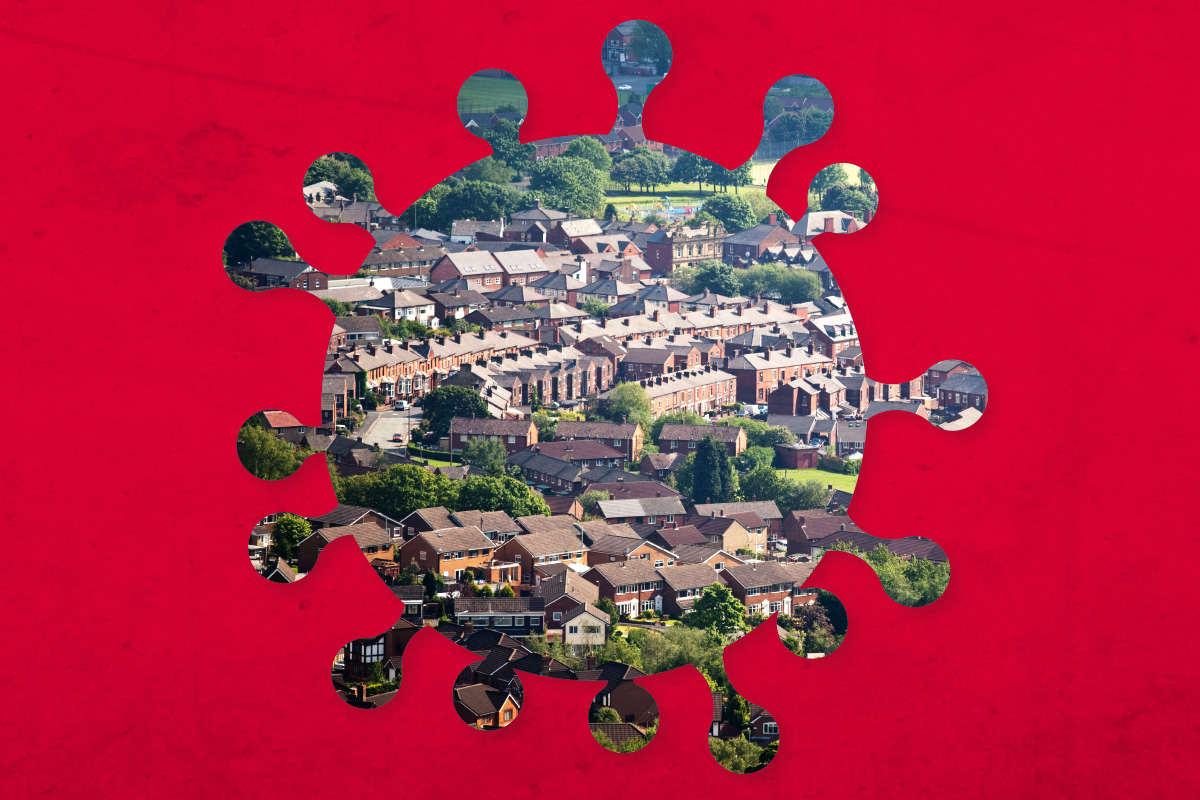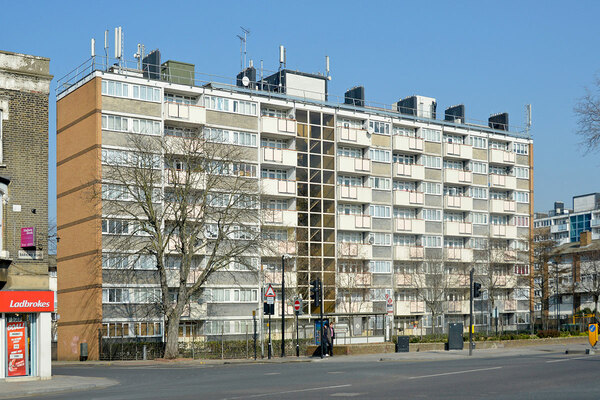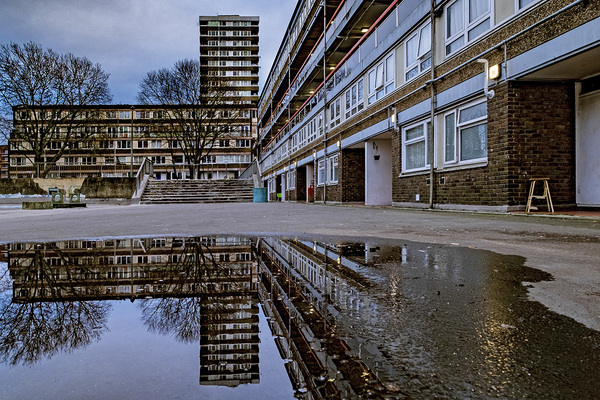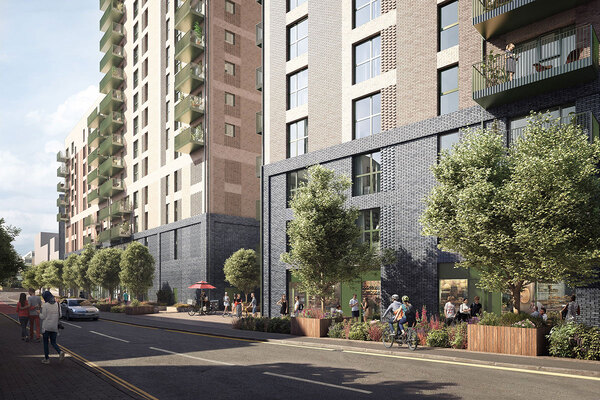You are viewing 1 of your 1 free articles
Redefining the purpose of social landlords in a post-pandemic recovery
Bolton at Home is looking to steer the recovery from the pandemic and use its research to reshape housing, social and economic policy. Martin Hilditch finds out how it is pushing for action – and why its work may be the guidebook to ‘levelling up’ we have been waiting for
What should social landlords’ purpose be in a post-pandemic world?
For Jon Lord, chief executive of housing association Bolton at Home, it is a profound – and profoundly worrying – question, in a world in which multiple local agencies are creaking under an immense strain.
“Local authorities are in a hell of a state,” he says. “They are not going to be able to provide direct services that were taken for granted 10 years ago. The health service is under pressure, the police are under pressure.”
With local agencies struggling and unemployment rates rising, layered on top of years of underinvestment in the North, it is likely to be a difficult road to recovery. Mr Lord thinks the most urgent short-term priority for many landlords may be meeting people’s basic needs – and by that he means the very most basic of all.
“Where targets before were around technical stuff like revitalising the town centre, I think some of that needs re-evaluation,” he says. “Our first priority will be to feed people. It is as stark as that.”
To inform its approach, and to clarify what its mission should be, Bolton at Home has commissioned new research to help it manage the ongoing emergency effectively and prepare for recovery. But its ambitions do not stop there. It wants to use that learning to build a more resilient long-term future for the area. And that means looking at how best to reshape local and national housing, social and economic policy. Or, if Inside Housing can paraphrase wildly, a guidebook for levelling up.
So, how is Bolton at Home looking to drive change? For its chair Ian Munro, the work will not only inform the board’s thinking about how the landlord “might reframe what we are there to do”, it will also “help us to form the conversation with our partners, particularly Bolton Council”.
This last point is crucial, Mr Lord states, because with COVID-19 placing financial pressures on local services, “the only way agencies can help is in partnership”.
“We have all got to find a way of working together around a shared set of targets,” he says.
Mr Lord also has his sights set on the Treasury, and more specifically the 80:20 rule in its green book, which insists that 80% of Homes England funding from various pots must help unlock development in places where property is most unaffordable. This is a rule that the Homes for the North alliance of housing associations has campaigned to end – and Mr Lord thinks that if government is serious about levelling up, then it is time for it to put more thought into how it will deliver meaningful change.
“If national government is serious about levelling up, it has to bite the bullet,” he states. “I get incensed when you look at the last 30 years and the lack of investment, outside of welfare, that has gone into the North of England compared to the rest of England.”
So, what happens next?
To start the conversation, Bolton at Home has teamed up with Inside Housing to publish its emerging research and what its findings mean for associations, councils and other local partners, and central government.
Over the next few weeks, we will publish a range of research and accompanying analysis from researcher Brendan Nevin and Bolton at Home’s executive director of business development, Ian Ankers.
The first of these pieces is published on the right and looks at recent research into the resilience of neighbourhoods in Bolton, placing it in the national context of the impact of COVID-19 and pre-existing issues of social and economic polarisation in England’s urban areas. It makes the case for using evidence-based approaches to targeting investment and support to distressed communities in the post-emergency phase of the current crisis and argues for the need for radical and creative thinking nationally to address recovery and resilience issues in disadvantaged areas when we emerge into a post-pandemic world.
The work brings together a range of research reports including those conducted by the Office for National Statistics (ONS) and the Academy of Medical Sciences, along with local neighbourhood data.

In the coming weeks we will publish pieces looking at why so many communities have experienced poor economic, social and health outcomes from the crisis and what that means for the future in places like Bolton and the levelling up challenge across England.
This will culminate with a roundtable of local and national leaders at the start of next year that Inside Housing will help to facilitate and report on.
“We are not going back to normal,” Mr Ankers adds.
“Everyone should be reading this because we have all got to step up as partners.”
In the first in a series of thematic blogs, Mr Nevin sets out the findings of the Bolton work so far – and what some of the emerging lessons might mean for the recovery.
Planning for recovery and a more resilient future: learning the lessons
It is important to understand the past to develop effective strategies going forward.
Recent reports by the Institute for Fiscal Studies and the UK 2070 Commission have added to the large body of historic literature and reviews of the performance of UK towns and cities over the past two decades, which have regularly produced stark findings.
The research has consistently demonstrated that towns and cities that are mainly located outside London and the South of England have struggled to deal with the legacy of, and transition from, the industrial revolution to a service-led economy.
Since 1945 government policy has tended to recognise that particularly the nation’s towns, and some cities, have been vulnerable to change and that their evident social and economic difficulties have needed redistributive support to reduce disparities in the quality of life between different places.
Despite waves of regeneration initiatives in the period 1945-2010, many areas and communities became progressively more disconnected from growth; social mobility slowed and improvements in health and education fell behind the nation as a whole.
Even in the relatively successful London and South East regions, significant numbers of neighbourhoods and communities have struggled to access good quality affordable housing – a factor that has produced relatively high levels of child poverty. It is upon this spatially unequal urban and economic footprint that the pandemic has taken its highest human toll and amplified the lack of resilience and the impact of concentrated disadvantage in Britain’s poorest places.
Bolton at Home commissioned an impact analysis of the pandemic, building up a picture of changing social and economic conditions from neighbourhood level to get a view about priorities across the geography.
First wave of COVID-19 infections
The aim was to assemble information in real time that could help the organisation adjust to the shock and plan for the recovery using a standard disaster management framework. This covers the emergency, repair, recovery and resilience phases that follow the aftermath of a natural disaster.
The design of the research process was informed by national factors that epidemiologists had identified as being associated with concentrations of COVID-19 infection and quantifying and mapping those characteristics locally to develop a Community and Neighbourhood Risk Domain (CNRD) [1].
The rationale for developing the domain analysis was to identify the scale and concentration at neighbourhood level of the factors that are strongly associated with COVID-19 outcomes. These include severity of deprivation, population density and poor-quality housing, residents who work in vulnerable sectors of the labour market, older people and BAME communities. High scores on this composite index are consistent with a lack of resilience, which can be addressed by investment programmes and changes to public policy following the emergency [2].
As the outcome sought from analysing neighbourhoods in this way was to identify the scale of resilience issues that will need to be addressed, only neighbourhoods located in the worst two deciles nationally for outcomes were allocated a score on the risk domain.
For Bolton neighbourhoods, high scores on the Index of Multiple Deprivation (IMD) were also associated with high scores on the CNRD. However, when measuring the intensity of resilience issues, the introduction of other factors highlighted nationally altered the national ranking of the most deprived neighbourhoods on the national CNRD compared with the IMD. This shows additional localised risks and more challenging issues relating to resilience.
Those locations with the worst outcomes scored seven and eight (out of a possible 10). Nationally 1.3% of dwellings were in Local Super Output Areas that scored in the highest two measurements, while in Bolton the figure was 7.3%. This represented an enhanced risk factor locally compared to measuring by IMD alone, where only 0.7% of dwellings were located in the poorest 1% of neighbourhoods.
Moving along the scale of risk, if the domain is analysed to identify places above a score of six, then 13.9% of dwellings locally are captured but only 2.9% nationally. Bolton at Home stock was even more over-represented in areas with evident resilience issues, with more than a quarter of its homes located in neighbourhoods with a score of six or more. Fifty-seven per cent of stock is in neighbourhoods with a score of more than four, highlighting its importance as an anchor institution that remains committed to meeting the needs of communities along with other agencies that have the same long-term, area-based focus.
The CNRD for Bolton
A final point to highlight the demonstrable relationship between what has actually happened compared to the theoretical map of risk: those locations with the worst outcomes scored seven and eight (out of a possible 10). Nationally, 1.3% of dwellings were in areas that scored in the highest two measurements, while in Bolton the figure was 7.3%. This represented an enhanced risk factor locally compared to measuring by IMD alone, where only 0.7% of dwellings were located in the poorest 1% of neighbourhoods.
The CNRD for Bolton is mapped above. Its close association with the map of COVID-19 infections in the first wave to September is evident below it, where the red identifies neighbourhoods with 2.5 times the national infection rates, and dark and light pink registers infections above the average by a factor of two and 1.5 respectively. Eighty-five per cent of Bolton at Home stock is in neighbourhoods classified as red or pink.
A further challenging outcome was highlighted by the development of a separate COVID-19 economic impact analysis in Bolton. Significantly the same neighbourhoods appear when intensity of risk and public health and economic impact are measured. So, those neighbourhoods with the most serious public health outcomes also tend to have suffered the most from the economic shock.
Evidence generated nationally and in this case study highlights critical issues relating to recovery and resilience that will have to be addressed given the evidence of the impact of COVID-19 in historically disadvantaged places: housing quality and overcrowding; health inequality; deprivation in its widest sense; and insecure and inadequate employment. All are challenges but we will need to develop a strategy to manage our ageing society and invest heavily in the zero-carbon agenda.
Not responding to the challenges posed by the pandemic does not appear to be a viable proposition given the fast-evolving social, economic and human crisis we face in the post-disaster phases.
Notes
[1] It is important to be clear that this mapping identifies only neighbourhood characteristics that are associated with COVID-19 concentrations. It is not a predictive model and randomly distributed characteristics such as the location of hospitals and care homes can alter actual outcomes, for example.
[2] The indicators therefore that were included in the domain included: the poor public health outcomes experienced by BAME communities during the pandemic; pre-existing poor health was captured through the health component of the IMD; age profile was identified via ONS; housing indicators were derived from blending ONS and census data to provide an up-to-date estimate of neighbourhood condition. All this data was gathered at Local Super Output Areas that have an average population of 1,500. The results were then modelled nationally with each individual area given an individual score and ranked within the 34,753 areas on the dataset.
















